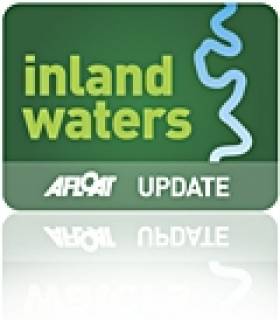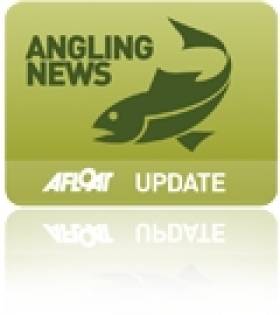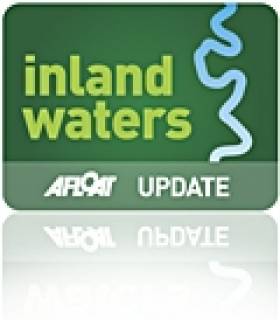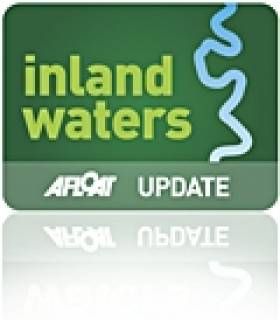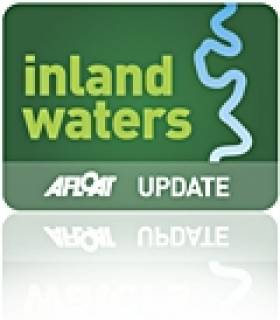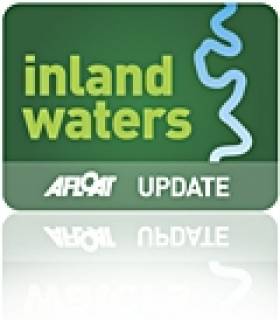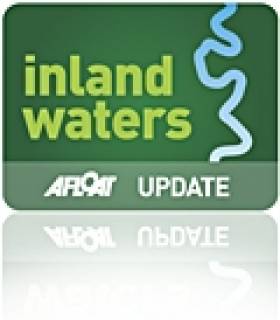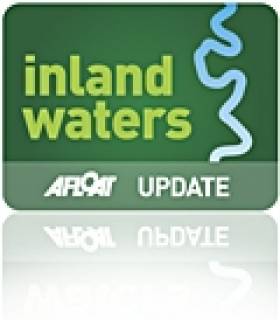Displaying items by tag: Grand Canal
#InlandWaters - Waterways Ireland has confirmed that the construction project to develop houseboat mooring facilities for the Grand Canal in Sallins, Co Kildare has now recommenced on site.
It's now advised that as a consequence of the delay, which Waterways Ireland assures was unforeseen, the contract will now be completed in August.
Waterways Ireland says it "will ensure that the previous contractual difficulties do not result in any reduction in the quality or standard of the completed project.
"Waterways Ireland apologies to customers, residents and local businesses for any inconvenience caused by the unforeseen delay to the contract."
For further information please see Waterways Ireland's current Waterway Work Programmes.
Enquiries relating to the Sallins Houseboat Facility project are directed Waterways Ireland's on-site representative at 087 990 1935.
Angling Seniors and Juniors Spring Into Action
#Angling - The National Coarse Fishing Federation of Ireland (NCFFI) will host its annual Senior Canals Championship on the Grand Canal at Daingean, Co Offaly in two weekend's time on Saturday 3 and Sunday 4 May, just before the bank holiday.
Sponsored by Waterways Ireland, the championship and the biggest canal angling event of the year, attracting participants from all over the country and the UK who will be welcoming the warming inland waters with eager anticipation of some fantastic catches.
For more information see the NCFFI Facebook page HERE.
In other news, the River Erne in Enniskillen will be the venue for Waterways Ireland's Junior Angling Classic series, running over three successive Saturdays from 26 April.
Organised by the Erne Anglers Club in partnership with Waterways Ireland, NI's Department of Culture, Arts and Leisure and Fermanagh District Council, the series gives ing children aged 11 to 19 the change to test their mettle in competitive angling.
Fishing in Ireland has more details about the initiative HERE.
Boating Traffic on the Grand & Royal Canals & River Barrow to be Impacted By Bye–Laws – IWAI
Carmel Meegan, President of the Inland Waterways Association of Ireland (IWAI) welcomed delegates to the IWAI National Council meeting in Tullamore on 8th confirmed that the proposed bye-laws do not put user requirements, local communities or tourism at the centre of the regulations. Delegates heard –
In general –
there are reports that boats present this time last year have now left the Canals – the IWAI says this is indicative of boaters' fears and a further future drop in navigation use
Waterways Ireland have suggested that the 1800 plus submissions delivered by IWAI - during the brief consultation period of only 21 days- are letters in support of the IWAI
Submission rather than viewing these as other individual submissions recognising the effort and concern held by wider communities
Waterways Ireland imposed restrictions never previously invoked on boats travelling by Canal to the Dublin Rally in 2014 – which is celebrating 40 years of community activity
the proposed toll €75 to travel between the Grand and Royal Canals is detrimental – the IWAI advises this is the now most expensive boat crossing in Europe
the Newcomen lifting bridge will open only 8 times this year, only 96 boats are permitted to undertake the Green & Silver route around the Grand and Royal Canals this season due to restrictions of use of the Newcomen lifting bridge, significantly curtailing the emerging 'Green & Silver' route – the IWAI advises this is a major miss for domestic and international boat tourism.
Concerns aired as to the Canals and Barrow as a tourism resource have included questions in the Seanad and the Dail; County Council input; national and local press articles; television and radio interviews; community websites; blogs and Facebook pages reflecting overall national concern.
Politically, this has grown to be a very big issue and is featuring highly as politicians face into local elections this summer. The IWAI have gained the interest of local, regional and national
politicians on this matter to date, and will present our position to the Oireachtas Joint Committee on the Environment, Culture and the Gaeltacht in Leinster House on 25th
The boating community is not averse to appropriate management, facility provision, and access to waterways. But boats are key attractions, as the lifeblood of the navigations, and need to be welcomed.
#grandcanal – Waterways Ireland advises owners and masters that due to essential electrical and mechanical maintenance the Sea Lock at Ringsend (Buckingham Lock) is closed to navigation until further notice. This will prevent boat passage between Grand Canal Basin and the River Liffey whilst maintenance works are ongoing.
As works progress it may be possible to make passage by prior arrangement, but this will be entirely dependent on the stage of works. If wishing to make arrangement please contact the Dock Superintendent, Mark Clarke, on 087 258 4713, who will be able to advise accordingly.
Dublin Boat Passages on the Grand Canal to be Done in a Single Movement
#grandcanal – Waterways Ireland wishes to advise masters and owners that boat passages in or out of Dublin on the Grand Canal Main Line between Locks 1 & 12 should generally be undertaken as a single movement in one day.
A minimum of two working days' prior notice of intended travel is requested to be given to the Waterways Ireland Eastern Regional Office, to facilitate the necessary staffing assistance arrangements. To allow time for passage boats will only be permitted entry before 9:00am at either the Lock 1 or Lock 12 depending on direction of travel. This may be earlier depending on the number of boats making passage.
Please also ensure you have the following before making passage:
-adequate fuel on board
-competent and adequate crew to operate the boat and locks
(minimum crew of 3)
-a lock key on board your boat
-mooring lines of adequate length to handle vessel through a lock
(approx 15m length)
-no known mechanical problems with your boat
Boats will not be permitted to travel the system if their passage is considered to be unsafe by Waterways Ireland and / or if they do not have the appropriate permit.
Relevant Contact Details for Waterways Ireland, Grand Canal, Dublin:
Waterways Ireland Eastern Regional Office (M-F 9.30am-4.30pm)
01-868-0148
Dock Superintendent, Ringsend
Mark Clarke 087-2584713
Lock-keeper, Locks C1 to C7, Circular Line
Stephen Brierley 086-3805657
Lock-keeper, Locks 1 - 6, Main Line
Ray Moore 086-8278025
Lock-keeper, Locks 7 - 11, Main Line
John O'Brien 087-2683723
Lock-keeper, Locks 12 - 13, Main Line
Ray Moore As above
Sailing Vessel Sunk on Grand Canal at Shannon Harbour
#grandcanal – Waterways Ireland advises masters and owners that a small unidentified sailing vessel is sunk in Shannon Harbour approx. 500 metres East of Griffith Bridge on the south bank.
The vessel is an obstruction to navigation.
The mast is lying across the navigational channel, however, the vessel may be passed with due caution. It is planned to remove the vessel on Friday morning, 28th Feb 2014.
#byelaws – Waterways Ireland invites people and organisations affected by the changes to the Draft Canals Act, 1986(Amendment) Bye-Laws, 2014 to make submissions to Waterways Ireland before the 3rd February 2014.
All the documents are available online and can be viewed by arrangement in Waterways Ireland offices in Enniskillen and Dublin. Submissions can be made online, by email, by post and by visiting Waterways Ireland offices.
Submissions are being sought on changes to the Bye-Laws on the Grand Canal, Royal Canal and Barrow Navigation. The Draft Canals Act, 1986(Amendment), Bye-Laws, 2014 includes a new management framework which will be used to manage continuous cruising, houseboats, dry dock facilities as well as key location & serviced mooring usage. The amendments also include changes to mooring times, charges and the introduction of a fixed penalty notice.
Waterways Ireland will consult with the groups representing the views of people affected by statutory equality regulations such as disability or age based groups. In addition Waterways Ireland will be holding meetings with groups where their members will be affected by the changes to the Bye-Laws. Letters have also been issued to all permit holders on the navigations affected by the Bye-Law changes informing them of the public consultation and the availability of the documentation.
The period for submissions is set by the Section 7(1) of the Canals Act, 1986 (No.3 of 1986) as amended by section 56 of the Maritime Safety Act, 2005 (No. 11 of 2005). The deadline for submissions is the 3rd February 2014. Documentation is available from www.waterwaysireland.org/Public-Consultation or from Waterways Ireland offices as listed.
Grand, Royal Canals & Barrow Navigation Planned Closures
MARINE NOTICE
No 130 of 2013
GRAND, ROYAL CANALS AND BARROW NAVIGATION PLANNED WINTER CLOSURES
2013-2014
Waterways Ireland wishes to advise Masters and owners of vessels that the following planned closures will be in place for the winter of 2013-2014.
Grand Canal – Main Line
Circular Line, Dublin The Circular Line of the Grand Canal is closed to navigation between Lock C3 (Upper Mount Street) and Lock C5 (Leeson Street) from October to December 2013 to facilitate the installation of new lock gates.
Ardclough, Co. Kildare The Grand Canal is closed to navigation on the 13 th Level, downstream of Ponsonby Bridge near Ardclough, Co. Kildare, from November 2013 to February 2014 to facilitate works by Kildare County Council associated with the construction of a new distribution watermain.
Sallins, Co. Kildare The public moorings immediately East and West of Sallins Bridge are closed until mid-March 2014 to facilitate the construction of new houseboat and public jetty facilities.
Ballycommon to Clonony,
Co. Offaly The Grand Canal is closed between the 34 th Lock at Clonony and the 21 st Lock at Ballycommon from Monday 4 th November until Friday 20 th December 2013 to facilitate maintenance works.
Grand Canal – Barrow Line
Vicarstown, Co. Laois Possible closure of the canal in the Vicarstown area to facilitate bridge repairs – further details to follow.
Royal Canal
Spencer Dock,
Newcomen Bridge There will be no further lifts of Newcomen railway bridge until the 2014 boating season.
Ashtown to Castleknock,
Dublin 15 The towpath of the Royal Canal between Ashtown (10 th Lock) and Castleknock (12 th Lock) is closed from October 2013 to February 2014, to facilitate the construction of new cycle path facilities. An alternative route for towpath users will be sign-posted.
41 st Level, Mosstown,
Co. Longford The Royal Canal is closed at Mosstown until further notice due to a collapsed culvert.
Barrow Navigation No closures are planned.
Charles Lawn
Lt Cdr(rtd)
Inspector of Navigation
21 November 2013
Tel: 353 90 6494232
Fax: 353 90 6494147
#waterland – Minister Deenihan launched 'Water Land', an exhibition of sculpture and craft presented by Waterways Ireland Tuesday 5th November 2013—Jimmy Deenihan, T.D, Minister for Arts, Heritage and the Gaeltacht, with Dawn Livingstone, Chief Executive of Waterways Ireland, launched 'Water Land', a free exhibition of sculpture and crafted objects on the waters of Dublin's Grand Canal Basin.
This exhibition brings together the heritage of the inland waterways with new work by contemporary artists and craft makers. Curated by Sarah Ross, it will feature a selection of Ireland's most well known and recognised artists and craftspeople, those resident in the Design Tower, Pearse Street together with makers invited from across Ireland and abroad. Launching the exhibition in the Waterways Ireland Visitor Centre, Minister Deenihan said, "The diversity of materials and approaches that the artists have used in their work speaks to the fascination we all have with water and how we interact with it in our daily lives.
The Design Tower have put on a wonderful exhibition on this compelling theme and Waterways Ireland and the Crafts Council deserve great credit for their support." Dawn Livingstone, Chief Executive of Waterways Ireland, also highlighted the huge variety of stimulation that the artists drew from the waterways; from the recycling of waterway infrastructure (the lock gates) by Emmet Kane, through to the swimmers beautifully captured by the work of Alan Ardiff. "Each has brought their own view to this most unique resource, it is truly inspirational." Amongst others, the exhibition will feature renowned jewellery designer, Alan Ardiff who reminds us of the recent summer heatwave with his diving bronze figure inspired by the daredevil swimmers in Grand Canal Basin. Similarly, artist and sculptor, Elizabeth O'Kane, and bespoke jewellery designers, Da Capo, have produced exquisite work inspired by the movement and fluidity of water.
Referencing values associated with the use of water are fashion designer, Róisín Gartland whose work references the abuses in the fashion industry for the sake of western beauty and adornment, and ceramic artist, Henry Pim, who reminds us of the depletion of water as a resource. Despite the geographic divide between Connemara-based basketmaker, Joe Hogan and the Swedish textile designer, Liz Nilsson, both makers' work is inspired by the natural materials sourced from the water's edge.
This is further complemented by a series of sculptural forms by Kildare's internationally renowned woodturner, Emmet Kane, created from reclaimed canal gates made from the hardwood called 'Ekki'. Waterways Ireland, one of the six North/South Implementation Bodies established under the British Irish Agreement in 1999, has responsibility for the management, maintenance, development and restoration of inland navigable waterways principally for recreational purposes.
Due to both its historical significance and current value the element of water was seen as a very relevant theme to promote the work of over 20 artists and makers at the Waterways Ireland Visitor Centre.
'Water Land' is supported by Waterways Ireland and further funded by the Crafts Council of Ireland. Exhibition opening times for visitors are from Wednesday to Sunday, 10am–6pm and entry is free of charge.
Moorings Upgrade at Sallins, Grand Canal
#grandcanal – Waterways Ireland is upgrading the moorings and services on the Grand Canal in Sallins, Co Kildare to create Houseboat Moorings to facilitate the boating customers in the area. The contract has been awarded and the work is expected to take place during the closed navigation season and be ready for the new boat season in 2014.
The 210m Houseboat Moorings are to be installed east of Sallins Bridge. The moorings will have electricity, water, lighting and access to a sewage pumpout and rubbish disposal facilities. The existing canal bank will also be landscaped with pathways designed in accordance with Waterways Ireland 'Access for All' standards. These moorings will be open to application from permanent boat residents holding a Combined Mooring and Passage Permit (CMP).
In addition to the Houseboat Moorings, an area for 240m of Extended Mooring west of Sallins Bridge is also being prepared where boat owners already in possession of a CMP will be able to apply for a 1 year mooring license –an Extended Mooring Permit.
A short term mooring for boats continuously cruising is also being installed east of Sallins Bridge. These moorings will have bollards providing water.
As the majority of the works to create the houseboat moorings will be undertaken from the water, boats currently moored there have been required to move. This phase has been completed and the contactor is currently preparing to move on site.
The Extended Moorings will be offered as a first option to those moving to facilitate the work. Boaters wishing to move to the Extended Moorings in Sallins are advised to complete the application online on www.waterwaysireland.org as soon as possible. Moorings will be allocated on a first come first served basis.
Waterways Ireland has met with Permit holders locally and is taking their concerns on board. Waterways Ireland will continue to liaise personally with Permit Holders and with the local community through the local press to ensure all are kept up to date with progress.


























